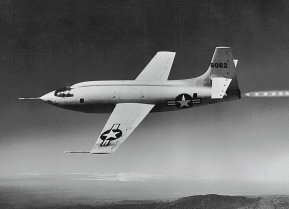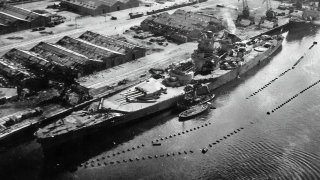Navy Battleship Massachusetts vs. France's Battleship Jean Bart: Who Won?
During the naval engagements – known collectively as the Naval Battles of Casablanca and fought from November 8 to 16 – the still incomplete French warship Jean Bart was hit by a total of five aerial bombs as well as shells from the U.S. Navy's South Dakota-class battleship USS Massachusetts (BB-59).
The French Navy's Jean Bart Took On the USS Massachusetts: During the Second World War, Nazi Germany had a number of close European allies – notably Italy, Hungary, Finland, and Romania. In addition, the Germans set up puppet governments in Slovakia and Croatia.
Following the defeat of France in the spring of 1940, the Vichy regime, led by Marshal Philippe Pétain, collaborated with the German occupiers and enacted policies that aligned with German interests. However, a condition of the armistice of June 22, 1940, was that France would retain the French Navy (the Marine Nationale), under strict conditions. The Pétain government pledged that the fleet would never fall into German hands, but it refused to send the fleet beyond Germany's reach to the UK, America, or even far-away places in the French colonial empire such as in the West Indies.
That decision resulted in a battleship showdown between Vichy, France, and the United States.
History of the Richelieu-class Battleships
In the 1930s, fearing a potential war with Fascist Italy, the French Third Republic responded to the Italian Navy's (Regia Marina's) Littorio -class of battleships with its own new class of powerful yet fast capital vessels. The result was the Richelieu -class, and while based on the previous Dunkerque -class – and including the same unconventional arrangement that grouped the main battery forward in two quadruple gun turrets – the new warships were larger and featured a much more powerful main battery of eight 380mm (15-inch guns).
Additionally, the warships were protected by increased armor.
Four of the Richelieu-class battleships were laid down in the mid-1930s as the clouds of war were on the horizon. However, only the lead vessel was completed just after the war broke out. While the Richelieu eventually played a role in the conflict, the same wasn't to be true for Jean Bart.
Launched in 1940, she was not completed when the war broke, and the warship was moved to Casablanca in June of that year to avoid capture by the Germans. At the time, only one of the battleship's turrets out of a planned two was operational. A cargo vessel carried her second and still incomplete turret, which French authorities had planned to install at a later date – however, the cargo ship was sunk by a German submarine.
After arriving in Casablanca, the anti-aircraft guns on Jean Bart were removed to strengthen the port's defenses. However, after the French defeat during the Battle of France, a proposal was made to move the Richelieu, Jean Bart, and other warships to Oran to be demobilized. The Germans decided against it as it was feared the British would seize the ships. At the same time, the British military feared the Germans would seize the French warships, and that decision led to Operation Catapult, which involved a series of attacks on the French vessels that opted not to defect to the Free French.
As a result, Captain Pierre-Jean Ronarc'h prepared Jean Bart for a fight, and that included filling the incomplete turret with concrete, while the ship's anti-aircraft battery was strengthened. Instead of heading out to sea, the battleship essentially operated as a stationary shore battery at Casablanca.
Jean Bart During Operation Torch:
In November 1942, United States forces launched Operation Torch, which saw landings in Vichy-controlled North Africa. During the naval engagements – known collectively as the Naval Battles of Casablanca and fought from November 8 to 16 – the still incomplete French warship was hit by a total of five aerial bombs as well as shells from the U.S. Navy's South Dakota-class battleship USS Massachusetts (BB-59). One of those shells struck the French vessel, and while it didn't detonate, it jammed the turret and effectively put the Jean Bart out of action.

The French warship able to fire just seven rounds at the U.S. battlewagon before the turret rotating mechanism jammed. USS Massachusetts' heavy 16-inch projectiles caused significant damage to the Jean Bart, although few actually exploded because they had been fitted with fuses manufactured a generation earlier. Had they had exploded; it is likely Jean Bart would have been crippled.
Instead, the French battleship fought on, much to the surprise of the American forces. Finally, the aircraft carrier USS Ranger dispatched dive bombers, which successfully struck and sank Jean Bart in the shallow water.
Jean Bart Returned to Action
Soon after the Vichy French forces surrendered to the Allies, discussions began about raising the ship and towing her to the United States to complete her construction. In the end, this didn't happen and instead, the battleship remained in Casablanca harbor until the end of the war.

Only after the defeat of Nazi Germany was Jean Bart returned to France, and completed in 1949. She participated in the Suez Canal Crisis in Egypt in 1956 yet so no combat. Put in the reserve fleet in 1957, she was then decommissioned in 1961 and sold for scrap at the end of the decade.
Jean Bart may not have played a crucial role during the Second World War, but had she fallen into the hands of the Germans or the Italians, she could have shifted the balance of power in the Mediterranean in favor of the Axis.
Author Experience and Expertise: Peter Suciu
Peter Suciu is a Michigan-based writer. He has contributed to more than four dozen magazines, newspapers, and websites with over 3,200 published pieces over a twenty-year career in journalism. He regularly writes about military hardware, firearms history, cybersecurity, politics, and international affairs. Peter is also a Contributing Writer for Forbes and Clearance Jobs. You can follow him on Twitter: @PeterSuciu. You can email the author: [email protected].


